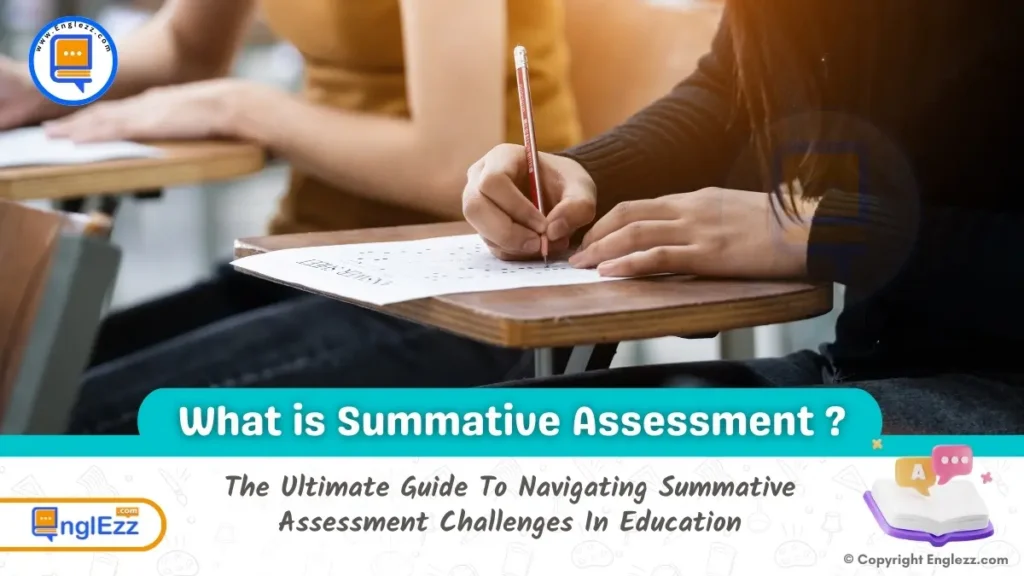Confused about summative assessment? I break down what it is, why it’s crucial, and how to implement it effectively. Get my expert guide with practical examples and a free planning template.
I’ve been in education long enough to see the terminology change, but the fundamental challenges remain. One of the most persistent questions I encounter from new and experienced educators alike revolves around a single, critical concept: summative assessment. What exactly is it, and how can we move beyond just slapping a grade on a unit and calling it a day?
What is Summative Assessment? An Educator’s Guide to Measuring Mastery
In this article, I will demystify summative assessment. We’ll move past the simplistic “test at the end” definition and explore it as a powerful tool for evaluating student learning, judging instructional effectiveness, and providing a crucial data point for the educational journey. This isn’t just theory; I’ll provide you with a practical, step-by-step framework for designing and implementing summative assessments that are rigorous, fair, and genuinely informative. Let’s transform this end-point into a meaningful milestone.
A Quick-Nav Table for This Guide
| Section | Key Takeaways |
|---|---|
| 1. Beyond the Final Exam: Defining Summative Assessment | Definition, core purpose (assessment of learning), key characteristics (high stakes, terminal, evaluative), and comparison with formative assessment. |
| 2. The “Why”: The Critical Role of Summative Assessment | Justifies its use for evaluating student mastery, judging instructional efficacy, providing accountability, and certifying competency. |
| 3. A Taxonomy of Summative Assessments: From Tests to Authentic Tasks | Categorizes and explains traditional (standardized, unit tests) and performance-based/authentic (projects, portfolios, performances) types. |
| 4. The Practitioner’s Blueprint: How to Design Effective Summative Assessments | A detailed 7-step guide covering alignment, clarity, variety, fairness, rubrics, scheduling, and reflective review. |
| 5. Common Pitfalls and How to Avoid Them | Discusses missteps like poor alignment, singular formats, “gotcha” tests, lack of transparency, and ignoring data, with expert mitigation strategies. |
| 6. Conclusion: The Summative as a Capstone, Not a Tombstone | A summary reinforcing summative assessment as a capstone event that should reflect a journey of learning, not just its end. |
| FAQs on Summative Assessment | Answers to the top 5 most frequently asked questions about retakes, grading, balance with formative, technology, and alternatives to tests. |
Beyond the Final Exam: Defining Summative Assessment
Let’s start with a clear, expert-level definition. Summative assessment is the process of evaluating student learning at the conclusion of an instructional period – be it a unit, a semester, or an entire course. Its primary purpose is to measure the level of proficiency or mastery students have achieved against a predefined set of standards or learning objectives.
Think of it as an autopsy versus a check-up. Formative assessment is the ongoing check-up: it diagnoses issues while the learning is still in progress, allowing for intervention and adjustment. Summative assessment, in contrast, is the autopsy: it determines what was ultimately learned after the instructional period has concluded. I use this analogy not to be morbid, but to emphasize the terminal nature of summative evaluation. It is the judgment, the final verdict on achievement for that specific learning segment.

The key characteristics that define a summative assessment are:
- High-Stakes Nature: It typically carries significant weight toward a final grade or promotion decision. This is what gives it gravitas.
- Terminal Point: It occurs after the learning cycle, not during it. It sums up the learning.
- Evaluative, Not Diagnostic: Its core function is to evaluate and grade the outcome of learning, not to diagnose learning processes in real-time.
While formative assessment is the compass that guides the journey, summative assessment is the destination’s coordinates, confirming where the learners have finally arrived.
The “Why”: The Critical Role of Summative Assessment in the Learning Ecosystem
In some progressive educational circles, summative assessment gets a bad rap. It’s seen as outdated, stressful, and antithetical to genuine learning. I understand this perspective, but I firmly believe that when designed and used correctly, summative assessment is not just necessary—it’s indispensable. Here’s why, from my professional experience.
First, it provides a definitive evaluation of student mastery.
We need a mechanism to answer the fundamental question: “Did the students learn what we intended to teach them?” Summative assessment offers a structured, standardized way to gather evidence and make that judgment. It tells us, the educators, the students, and the parents, whether the core learning objectives have been met.
Second, it serves as a critical barometer for instructional efficacy.
The results of a well-designed summative assessment are not just a reflection of the students; they are a mirror for the teacher. If a significant portion of the class fails to demonstrate mastery of a specific concept, that is powerful data. It forces me to ask: Was my instruction clear? Did I provide enough practice? Were the learning materials appropriate? In this way, a summative assessment directly informs my future curriculum planning and teaching strategies.
Finally, it fulfills a necessary function of accountability and certification.
Education systems, universities, and employers require reliable, standardized evidence of learning. Summative assessments provide the transcripts, the diplomas, and the certifications that communicate a student’s competencies to the wider world. They are the formal recognition of achievement.
A Taxonomy of Summative Assessments: From Traditional Tests to Authentic Tasks
When most people hear “summative assessment,” they picture a multiple-choice final exam. While that is one valid type, my philosophy is that our assessment methods should be as diverse as our learners and our learning objectives. Relying on a single format is a disservice to both. Let’s break down the taxonomy.
A. Traditional Assessments
These are often standardized and efficient for assessing a broad range of knowledge.
- Standardized Tests: State exams, AP tests, or international benchmarks like the PISA. They are designed for large-scale comparison.
- Unit Tests and Final Exams: The classic classroom tools. They are typically curriculum-specific and can include a mix of question types: multiple-choice, true/false, fill-in-the-blank, and short answer. They are excellent for assessing foundational knowledge and comprehension.
- Term Papers and Major Essays: These require students to synthesize information, construct arguments, and demonstrate deep understanding over an extended format. They assess higher-order thinking skills like analysis, evaluation, and creation.
B. Performance-Based / Authentic Assessments
This is where we can truly gauge the application of knowledge in real-world contexts. I have found these to be far more engaging and often more revealing of true mastery.
- Capstone Projects: A multifaceted assignment that serves as a culminating academic and intellectual experience. Students might design a solution to a real-world problem, conduct genuine scientific research, or create a complex business plan.
- Portfolios: A curated collection of a student’s work over time, demonstrating effort, progress, and achievement. The final portfolio review and defense is the summative component. I’ve seen portfolios reveal growth in ways a test never could.
- Performances and Demonstrations: A recital in music, a lab practical in science, a speech in debate, or a mock trial in law. The live performance is the summative assessment of their skills.
- Product Creations: Building a working model, designing a website, creating a piece of art, or developing a software application. The final product is assessed against specific criteria.
- Oral Examinations and Defenses: Common in graduate studies but highly effective in K-12, an oral defense of a thesis or project requires students to articulate their thinking and demonstrate deep, flexible understanding under questioning.
The most effective assessment strategies I’ve designed often blend these types. A unit on civil engineering might end with a traditional test on principles (knowledge) and a summative project where teams build and stress-test a bridge model (application).
The Practitioner’s Blueprint: How to Design Effective Summative Assessments in 7 Steps
This is the core of the guide—the actionable framework I’ve refined through years of trial, error, and success. Designing a high-quality summative assessment is a deliberate process. Follow these steps to ensure yours is valid, reliable, and fair.
Step 1: Start with the End in Mind – Align with Objectives
Before you write a single question, look at your learning objectives. What should students know, understand, and be able to do? Every element of your summative assessment must be directly aligned with one or more of these objectives. This alignment, known as construct validity, is non-negotiable. I create a simple table to map each assessment item to its corresponding objective. If an item doesn’t map, it gets cut.
Step 2: Define the Scope and Communicate Expectations with Crystal Clarity
Students should never walk into a summative assessment guessing what’s on it. Provide a clear, written guide that outlines:
- The content areas and skills being assessed.
- The format of the assessment (e.g., 25 multiple-choice, 3 essays, a product creation).
- The time allotment.
- The grading criteria or rubric.
This transparency reduces anxiety and allows students to prepare strategically. It assesses their knowledge, not their ability to decipher your testing secrets.
Step 3: Select the Appropriate Format(s)
Refer to the taxonomy in Section 3. Choose the format that best measures the targeted objective. Use multiple-choice for broad knowledge recall, but use an essay or a project to assess analysis and synthesis. Don’t be afraid to mix and match to get a holistic picture.
Step 4: Engineer for Fairness and Accessibility
This is a matter of equity. Your assessment must be designed to give every student a fair opportunity to demonstrate their learning. This means:
- Writing clear, unambiguous questions.
- Providing appropriate accommodations as outlined in IEPs and 504 plans.
- Allowing sufficient time for most students to complete the task.
- Avoiding cultural or linguistic bias in question phrasing.
A fair test measures a student’s understanding of the content, not their ability to overcome confusing instructions or unnecessary time pressure.
Step 5: Craft the Rubric Before the Assessment

For any non-standardized assessment (essays, projects, performances), you must create the scoring rubric at the same time you design the task. This forces you to clarify your expectations and ensures consistent, objective grading. A good rubric has:
- Clear Criteria (e.g., Thesis Statement, Evidence, Organization).
- Descriptive Performance Levels (e.g., Excellent, Proficient, Developing, Beginning).
- A sensible scoring system.
I share the rubric with students when I introduce the assessment task. It becomes a powerful tool for them to self-assess and guide their work.
Step 6: Implement and Administer with Consistency
Whether it’s a silent exam hall or a project deadline, the conditions for completion and submission must be consistent for all students. This ensures the reliability of your results.
Step 7: Analyze, Grade, and (Crucially) Reflect
After the assessment, the work begins. Grade consistently using your rubric. But then, take a critical step back. Analyze the data. Look for patterns in the errors. Which questions did many students miss? Which rubric criteria were consistently scored low? This data is gold. It tells you what was learned well and, just as importantly, where the instructional gaps were. This reflection closes the loop, directly influencing your next cycle of teaching.
Assessment Common Pitfalls and How to Avoid Them: An Expert’s Warning
Even with the best intentions, it’s easy to stumble. Here are the most common mistakes I’ve seen and made myself, and how to sidestep them.
- ❌ Pitfall 1: The Misalignment Trap. The test doesn’t match what was taught.
- ✅ Solution: Rigorously use the mapping table from Step 1. Peer review your assessments with a colleague.
- ❌ Pitfall 2: The Monolithic Format. Using only one type of assessment (e.g., only exams).
- ✅ Solution: Diversify your toolkit. Incorporate at least one performance-based task per semester.
- ❌ Pitfall 3: The “Gotcha” Mentality. Designing tricky questions to catch students out.
- ✅ Solution: Your goal is to reveal knowledge, not conceal it. Assess essential understanding, not trivial minutiae.
- ❌ Pitfall 4: The Black Box. Keeping the format and criteria a secret.
- ✅ Solution: Over-communicate. Provide study guides, exemplars, and rubrics well in advance.
- ❌ Pitfall 5: The Data Graveyard. Grading the assessments, recording the scores, and moving on.
- ✅ Solution: Dedicate time for the reflective practice in Step 7. Let the results inform your practice.
Conclusion: The Summative as a Capstone, Not a Tombstone
As I reflect on my own journey in education, my perspective on summative assessment has evolved. I no longer see it as a tombstone marking the end of learning, but as a capstone—a culminating stone that holds the arch of a learning journey together. It is a formal, necessary, and powerful moment of reckoning.
A well-executed summative assessment provides a clear, honest, and valuable snapshot of achievement. It respects the students’ effort by evaluating it fairly, and it respects the teacher’s craft by providing actionable feedback on its effectiveness. It is not the enemy of formative assessment; it is its necessary counterpart.
I encourage you to use this guide not as a rigid script, but as a framework for your own professional design process. Revisit your summative assessments. Challenge them. Ask yourself: Are they truly measuring what matters? Are they fair? Are they informative? When you can answer “yes” to these questions, you have transformed your summative assessments from a source of anxiety into a tool for genuine, recognized accomplishment.
FAQs on Summative Assessment
1. Should students be allowed to retake summative assessments?
This is a complex issue. My professional stance is that the primary goal is to document mastery. If a student can demonstrate mastery at a later date, there can be educational value in allowing a retake or a comparable alternative assessment. However, this must be managed carefully to avoid undermining the value of initial effort and to prevent teacher burnout. Policies should be school-wide, clear, and require students to complete specific corrective work before a retake.
2. How much should a summative assessment weigh on a final grade?
There’s no universal answer, but it should carry significant weight to reflect its purpose as an evaluation of cumulative learning. In a traditional grading system, a unit test might be 20-30% of a quarter grade, while a final exam or capstone project could be 10-20% of the entire course grade. The key is that the weighting should be proportional to the scope of the material and the learning objectives it assesses.
3. What is the ideal balance between formative and summative assessment?
The balance should heavily favor formative assessment. I advise a rough ratio of 80/20 or 90/10 in terms of quantity and teacher focus. The vast majority of classroom assessment should be low-stakes, formative feedback. The summative assessments are the periodic, high-stakes checkpoints that summarize the learning built from that ongoing formative process.
4. How can I use technology for summative assessments?
Technology is a powerful ally. Use it for:
- Efficiency: Online testing platforms can auto-grade multiple-choice and fill-in-the-blank questions.
- Authenticity: Students can create digital portfolios, blogs, videos, or websites as their summative product.
- Security: Tools like lock-down browsers can help maintain integrity for online exams.
- Data Analysis: Digital platforms often provide instant analytics on question performance, highlighting areas of class-wide weakness.
5. What are some alternatives to traditional exams for summative assessment?
There are many powerful alternatives, including:
- Detailed Case Study Analyses: Students apply their knowledge to a complex, real-world scenario.
- Design Sprints: A time-constrained period where students design a solution to a problem.
- Teach-Back Sessions: Students must teach a key concept from the unit to the class or a small group.
- Curated Digital Portfolios: With a reflective narrative, students select and justify their best work as evidence of mastery.
- Creation of a “Beginner’s Guide”: Students create a resource explaining the unit’s core concepts to a novice, proving their deep understanding.








